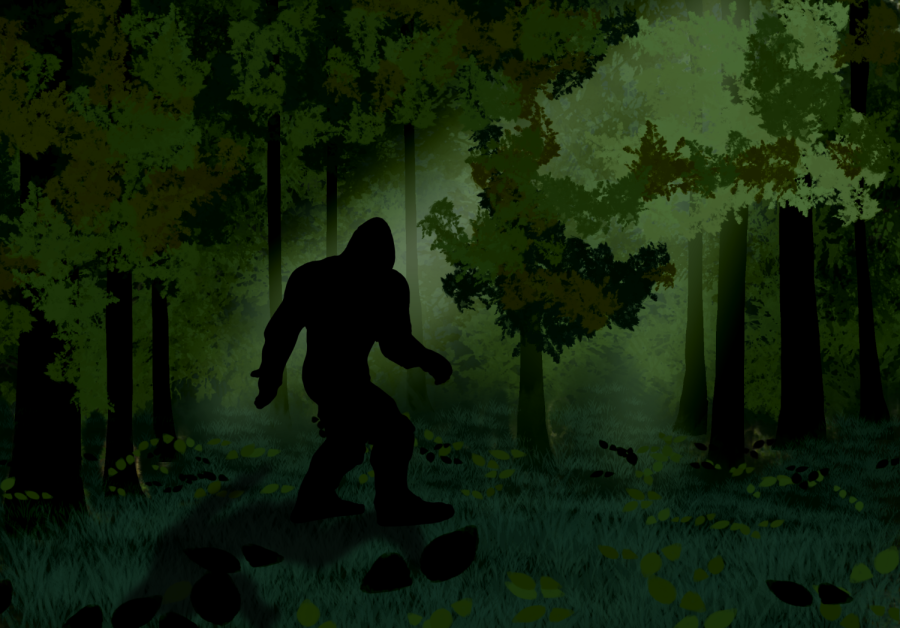The wilderness in the land of 10,000 lakes seems almost endless, and with that comes a plethora of creatures and cretins. Bears, mountain lions and deer are just a few of the animals that can be found roaming the forests, but could there be more out there than meets the eye?
Rumors of Bigfoot and Sasquatch have always circulated throughout Minnesota and the wider United States. Inexplicably large, humanlike footprints and seven-foot-tall humanoids in the distance seem to be common sightings all over the country, and there are plenty of people looking to find the beings behind them.
“Since the beginning we kind of heard weird noises,” said Brian Rapaway, founder of the Minnesota Bigfoot Society. “And the locals were saying there’s Bigfoot around there.”
Rapaway has 240 acres of land south of Motley, Minnesota. Near the road he displays a large, powder-coated plywood cutout of Bigfoot that he lights up at night for all to see.
Rapaway said while he has never laid eyes upon a Bigfoot or Sasquatch, he has experienced what he refers to as “suspicious Bigfoot activity.” Much of this suspicious activity, he said, occurs in the woods: weird smells, branches being thrown at him or strange feelings that he is not alone while hunting.
Rapaway said he believes that Bigfoot is not necessarily a solid entity like you or me. Rather, he believes it is an otherworldly entity lacking a concrete physical form.
There are many different interpretations of what bigfoot really is. Abe “Elusive1” Del Rio, the director of the Minnesota Bigfoot Research Team, believes Bigfoot is more akin to an advanced species of hominid.
“The footprints that have been found are more comparable to a human being,” Del Rio said. “We want to be scientifically talking about that science.” Del Rio also hypothesized that Bigfoot travel in packs together.
Del Rio takes pride in his and his organization’s scientific approach to Bigfoot. They also try to avoid calling it “hunting,” as it implies they are attempting to capture and kill a Bigfoot, which they are not. Instead, Del Rio prefers to call them Bigfoot “outings” or “expeditions.”
“We will shoot one, absolutely, if we are threatened or our lives are at risk,” Del Rio said. “Otherwise, the only way we will shoot one is with a Canon camera.”
Among their methods of research are vocalization (howling or loudly mumbling to mimic a Bigfoot), tree-knocking (slamming sticks against a tree to communicate with a potential Bigfoot in the area) and video analysis.
Who better to do this analysis than someone who says they have seen Bigfoot on three separate occasions?
“Tall, slender, not fat and covered in hair,” is how Mike “Pops” Hexum, a field researcher for the Minnesota Bigfoot Research Team, described the Bigfoot he has encountered.
Hexum said he has seen a Bigfoot three separate times in his life, the first when he was hunting at the age of 14. He said his father told him to keep his Bigfoot stories to himself as people might find it off-putting.
Over the phone, Hexum also gave examples of the types of vocalizations one might do to try and communicate with or draw out a Bigfoot. He howled and murmured, imitating noises he had heard in the forest and attributed to Bigfoot.
The success of these calls is hard to say. Hexum and Del Rio said while they often hear responses to their vocalizations, they can never quite catch up enough to capture a Bigfoot on camera.
Del Rio described wielding a camera and being just three seconds behind a Bigfoot with his team members, but not quite making it in time. He went on to say his 23 years as a Bigfoot researcher are full of such stories: always just far enough away to miss out on the action.
Hexum said these near misses are not abnormal, though juvenile Bigfoot tend to be more curious and likely to take risks.
So, are there Bigfoot roaming through the forests of Minnesota? Are they the missing link in our evolutionary history, or some ethereal being beyond humanity’s comprehension? Probably not, but the forests of Minnesota certainly have some mysteries within their trees, so who’s to say?
One thing is certain: If you hear howling and tree-knocking the next time you’re in the woods, don’t brandish a weapon in the hopes of slaying Bigfoot; it might just be your local team of Sasquatch searchers.
Even if it isn’t, you don’t want to be the person threatening a seven-foot-tall ape-man with a weapon — do you?













Faw
Dec 10, 2022 at 4:13 pm
nooooo
I don’t want another claude memory losss